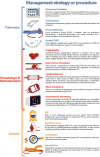Extracorporeal Membrane Oxygenation for COVID-19: Updated 2021 Guidelines from the Extracorporeal Life Support Organization
- PMID: 33657573
- PMCID: PMC8078022
- DOI: 10.1097/MAT.0000000000001422
Extracorporeal Membrane Oxygenation for COVID-19: Updated 2021 Guidelines from the Extracorporeal Life Support Organization
Abstract
This is an updated guideline from the Extracorporeal Life Support Organization (ELSO) for the role of extracorporeal membrane oxygenation (ECMO) for patients with severe cardiopulmonary failure due to coronavirus disease 2019 (COVID-19). The great majority of COVID-19 patients (>90%) requiring ECMO have been supported using venovenous (V-V) ECMO for acute respiratory distress syndrome (ARDS). While COVID-19 ECMO run duration may be longer than in non-COVID-19 ECMO patients, published mortality appears to be similar between the two groups. However, data collection is ongoing, and there is a signal that overall mortality may be increasing. Conventional selection criteria for COVID-19-related ECMO should be used; however, when resources become more constrained during a pandemic, more stringent contraindications should be implemented. Formation of regional ECMO referral networks may facilitate communication, resource sharing, expedited patient referral, and mobile ECMO retrieval. There are no data to suggest deviation from conventional ECMO device or patient management when applying ECMO for COVID-19 patients. Rarely, children may require ECMO support for COVID-19-related ARDS, myocarditis, or multisystem inflammatory syndrome in children (MIS-C); conventional selection criteria and management practices should be the standard. We strongly encourage participation in data submission to investigate the optimal use of ECMO for COVID-19.
Copyright © ELSO 2021.
Conflict of interest statement
Disclosure: Dr. Stead is a chief executive officer of the Extracorporeal Life Support Organization (ELSO). Dr. Paden is a president of the ELSO. Multiple patents and intellectual property regarding a novel renal replacement device to be used with extracorporeal membrane oxygenation (device not discussed in this article). Dr. Bartlett serves on ELSO’s board of directors. Dr. Barrett received grants from Getinge and ALung. Dr. Combes received grants from Getinge and personal fees from Getinge, Baxter, and Xenios outside the submitted work. Dr. Lorusso is a consultant for Medtronic, LivaNova, and Eurosets (all honoraria paid to the University). Dr. Ogino is a past-president of the ELSO; he serves on ELSO board of directors. Dr. Schmidt receives lecture fees from Getinge, Xenios, and Drager outside the submitted work. Dr. Shekar acknowledges research support from Metro North Hospital and Health Service. Dr. MacLaren serves on ELSO’s board of directors. Dr. Brodie receives research support from ALung Technologies. He has been on the medical advisory boards for Baxter, Abiomed, Xenios, and Hemovent. He is the President-elect of the ELSO. The remaining authors have no conflicts of interest to report.
Figures



References
-
- Extracorporeal Life Support Organization. ECMO and ECLS > Resources > Guidelines. Available at: https://www.elso.org/Resources/Guidelines.aspx. Accessed December 27, 2019
MeSH terms
Grants and funding
LinkOut - more resources
Full Text Sources
Other Literature Sources
Medical

